Marketing and Management Planning for Target Australia Pty Ltd Report
VerifiedAdded on 2023/04/20
|13
|4307
|119
Report
AI Summary
This report provides a comprehensive marketing and management plan for Target Australia Pty Ltd. It begins with an introduction outlining the company's background and the scope of the report, followed by an analysis of the key marketing issues, including lack of social media engagement, product duplication, poor market positioning, and inadequate online shopping services. The report then establishes SMART marketing objectives to address these issues, focusing on market positioning, social media utilization, and product differentiation. It proceeds to discuss market segmentation, targeting the women aged 30 with children and young professionals, and positioning strategies. Furthermore, the report examines the appropriate marketing mix, encompassing product, price, place, and promotion strategies, considering the company's strengths and weaknesses. The report concludes by emphasizing the role of the marketing plan in assisting the company in achieving its goals and sustaining a competitive edge in the Australian market.
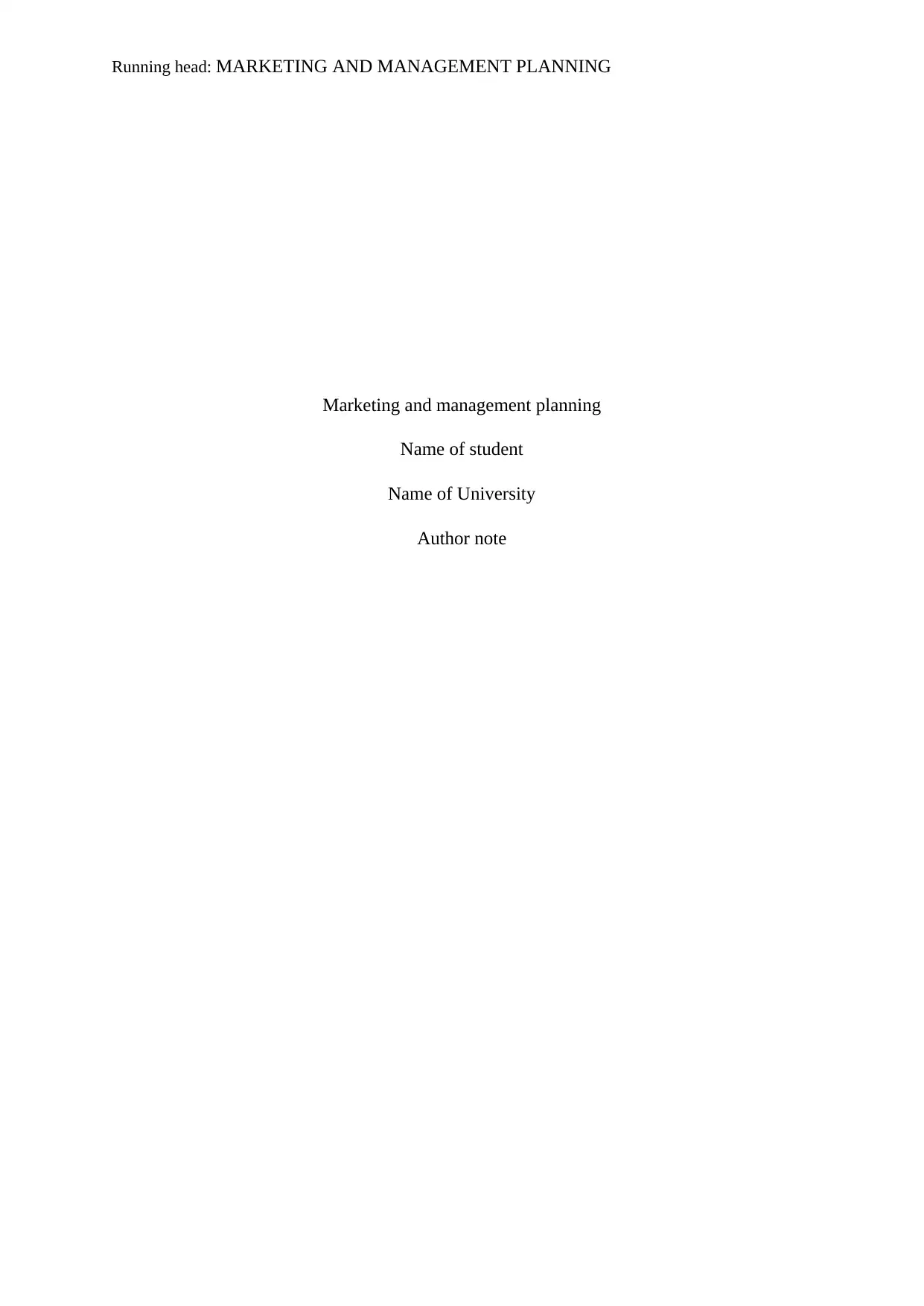
Running head: MARKETING AND MANAGEMENT PLANNING
Marketing and management planning
Name of student
Name of University
Author note
Marketing and management planning
Name of student
Name of University
Author note
Secure Best Marks with AI Grader
Need help grading? Try our AI Grader for instant feedback on your assignments.
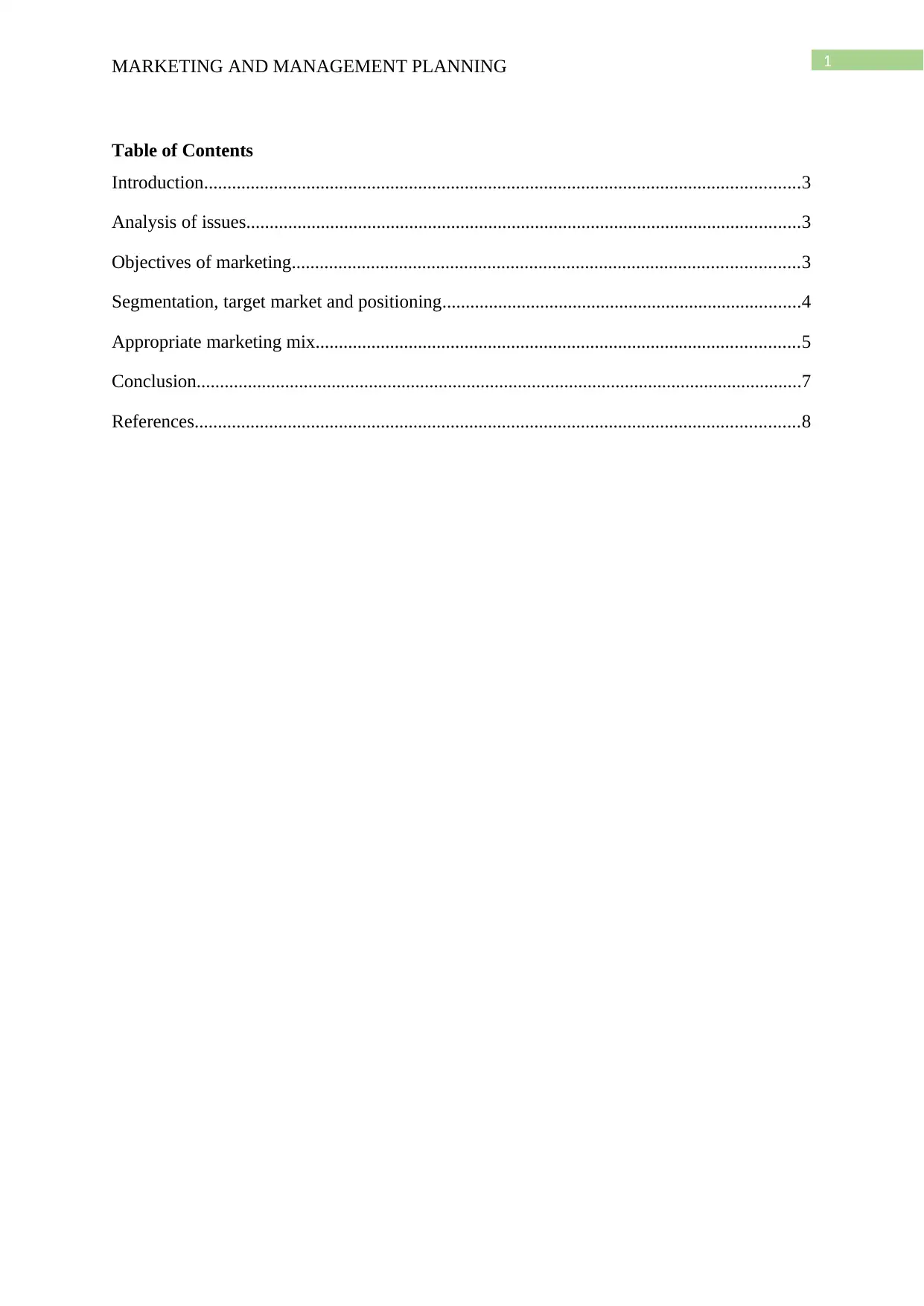
1MARKETING AND MANAGEMENT PLANNING
Table of Contents
Introduction................................................................................................................................3
Analysis of issues.......................................................................................................................3
Objectives of marketing.............................................................................................................3
Segmentation, target market and positioning.............................................................................4
Appropriate marketing mix........................................................................................................5
Conclusion..................................................................................................................................7
References..................................................................................................................................8
Table of Contents
Introduction................................................................................................................................3
Analysis of issues.......................................................................................................................3
Objectives of marketing.............................................................................................................3
Segmentation, target market and positioning.............................................................................4
Appropriate marketing mix........................................................................................................5
Conclusion..................................................................................................................................7
References..................................................................................................................................8
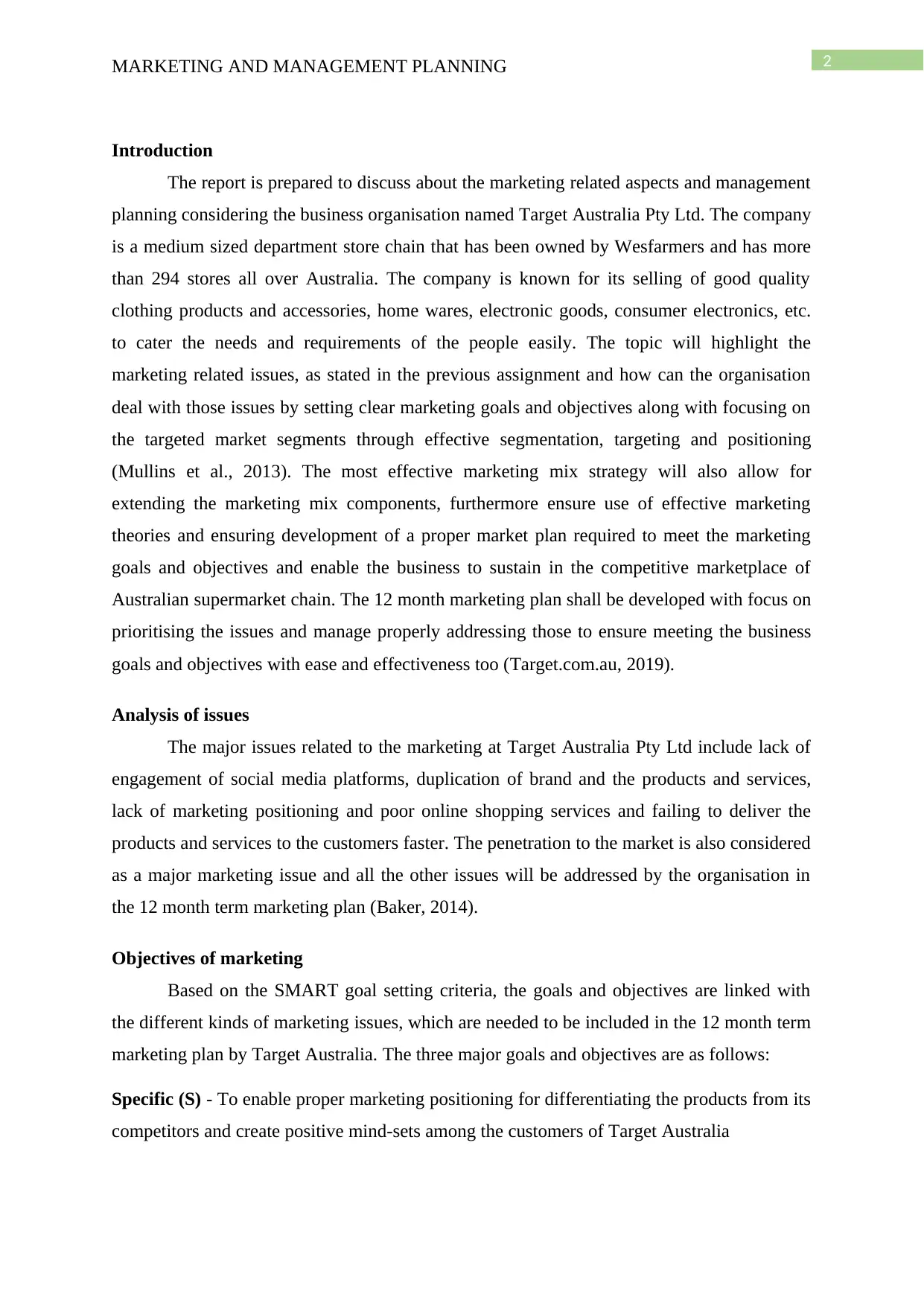
2MARKETING AND MANAGEMENT PLANNING
Introduction
The report is prepared to discuss about the marketing related aspects and management
planning considering the business organisation named Target Australia Pty Ltd. The company
is a medium sized department store chain that has been owned by Wesfarmers and has more
than 294 stores all over Australia. The company is known for its selling of good quality
clothing products and accessories, home wares, electronic goods, consumer electronics, etc.
to cater the needs and requirements of the people easily. The topic will highlight the
marketing related issues, as stated in the previous assignment and how can the organisation
deal with those issues by setting clear marketing goals and objectives along with focusing on
the targeted market segments through effective segmentation, targeting and positioning
(Mullins et al., 2013). The most effective marketing mix strategy will also allow for
extending the marketing mix components, furthermore ensure use of effective marketing
theories and ensuring development of a proper market plan required to meet the marketing
goals and objectives and enable the business to sustain in the competitive marketplace of
Australian supermarket chain. The 12 month marketing plan shall be developed with focus on
prioritising the issues and manage properly addressing those to ensure meeting the business
goals and objectives with ease and effectiveness too (Target.com.au, 2019).
Analysis of issues
The major issues related to the marketing at Target Australia Pty Ltd include lack of
engagement of social media platforms, duplication of brand and the products and services,
lack of marketing positioning and poor online shopping services and failing to deliver the
products and services to the customers faster. The penetration to the market is also considered
as a major marketing issue and all the other issues will be addressed by the organisation in
the 12 month term marketing plan (Baker, 2014).
Objectives of marketing
Based on the SMART goal setting criteria, the goals and objectives are linked with
the different kinds of marketing issues, which are needed to be included in the 12 month term
marketing plan by Target Australia. The three major goals and objectives are as follows:
Specific (S) - To enable proper marketing positioning for differentiating the products from its
competitors and create positive mind-sets among the customers of Target Australia
Introduction
The report is prepared to discuss about the marketing related aspects and management
planning considering the business organisation named Target Australia Pty Ltd. The company
is a medium sized department store chain that has been owned by Wesfarmers and has more
than 294 stores all over Australia. The company is known for its selling of good quality
clothing products and accessories, home wares, electronic goods, consumer electronics, etc.
to cater the needs and requirements of the people easily. The topic will highlight the
marketing related issues, as stated in the previous assignment and how can the organisation
deal with those issues by setting clear marketing goals and objectives along with focusing on
the targeted market segments through effective segmentation, targeting and positioning
(Mullins et al., 2013). The most effective marketing mix strategy will also allow for
extending the marketing mix components, furthermore ensure use of effective marketing
theories and ensuring development of a proper market plan required to meet the marketing
goals and objectives and enable the business to sustain in the competitive marketplace of
Australian supermarket chain. The 12 month marketing plan shall be developed with focus on
prioritising the issues and manage properly addressing those to ensure meeting the business
goals and objectives with ease and effectiveness too (Target.com.au, 2019).
Analysis of issues
The major issues related to the marketing at Target Australia Pty Ltd include lack of
engagement of social media platforms, duplication of brand and the products and services,
lack of marketing positioning and poor online shopping services and failing to deliver the
products and services to the customers faster. The penetration to the market is also considered
as a major marketing issue and all the other issues will be addressed by the organisation in
the 12 month term marketing plan (Baker, 2014).
Objectives of marketing
Based on the SMART goal setting criteria, the goals and objectives are linked with
the different kinds of marketing issues, which are needed to be included in the 12 month term
marketing plan by Target Australia. The three major goals and objectives are as follows:
Specific (S) - To enable proper marketing positioning for differentiating the products from its
competitors and create positive mind-sets among the customers of Target Australia
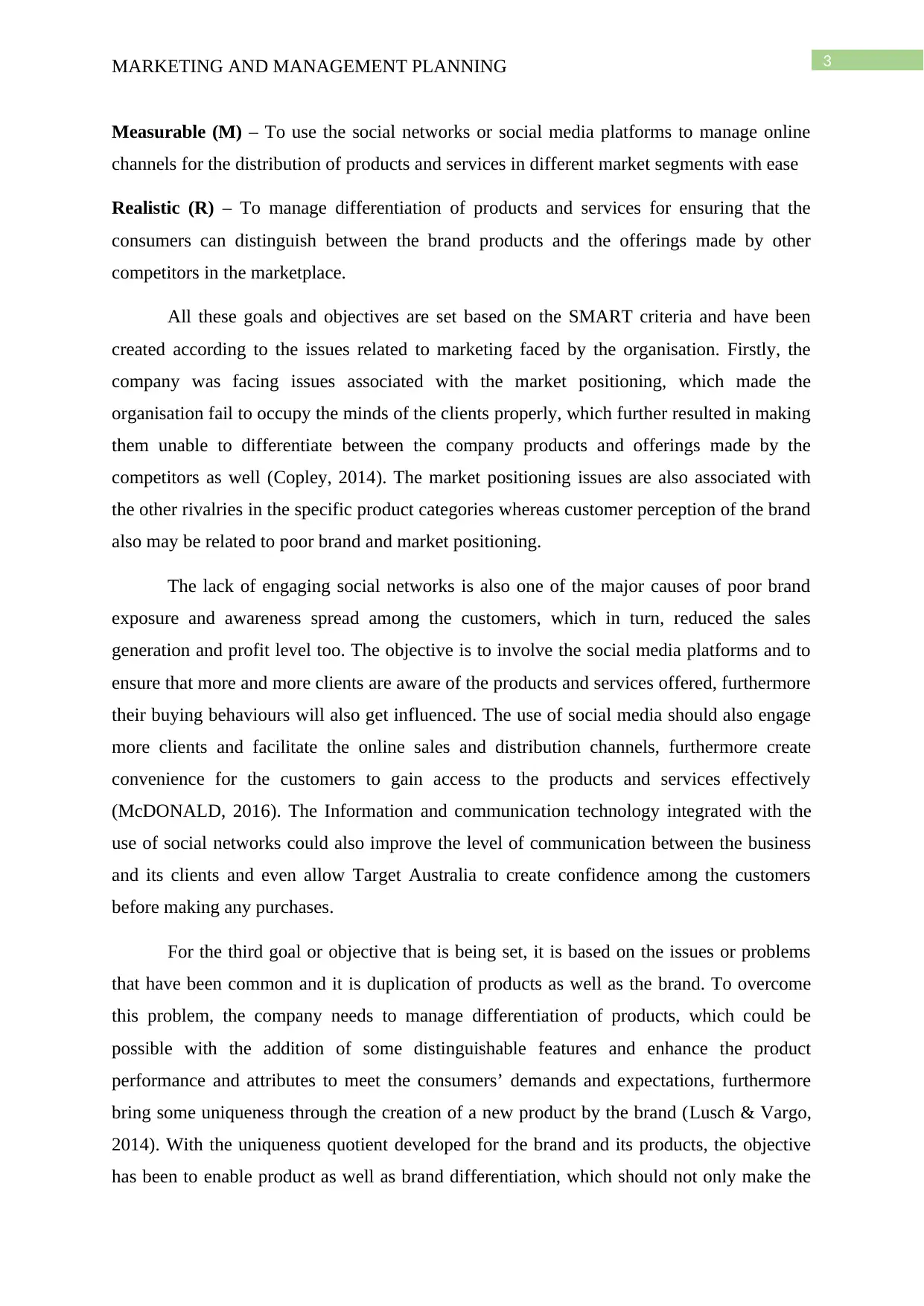
3MARKETING AND MANAGEMENT PLANNING
Measurable (M) – To use the social networks or social media platforms to manage online
channels for the distribution of products and services in different market segments with ease
Realistic (R) – To manage differentiation of products and services for ensuring that the
consumers can distinguish between the brand products and the offerings made by other
competitors in the marketplace.
All these goals and objectives are set based on the SMART criteria and have been
created according to the issues related to marketing faced by the organisation. Firstly, the
company was facing issues associated with the market positioning, which made the
organisation fail to occupy the minds of the clients properly, which further resulted in making
them unable to differentiate between the company products and offerings made by the
competitors as well (Copley, 2014). The market positioning issues are also associated with
the other rivalries in the specific product categories whereas customer perception of the brand
also may be related to poor brand and market positioning.
The lack of engaging social networks is also one of the major causes of poor brand
exposure and awareness spread among the customers, which in turn, reduced the sales
generation and profit level too. The objective is to involve the social media platforms and to
ensure that more and more clients are aware of the products and services offered, furthermore
their buying behaviours will also get influenced. The use of social media should also engage
more clients and facilitate the online sales and distribution channels, furthermore create
convenience for the customers to gain access to the products and services effectively
(McDONALD, 2016). The Information and communication technology integrated with the
use of social networks could also improve the level of communication between the business
and its clients and even allow Target Australia to create confidence among the customers
before making any purchases.
For the third goal or objective that is being set, it is based on the issues or problems
that have been common and it is duplication of products as well as the brand. To overcome
this problem, the company needs to manage differentiation of products, which could be
possible with the addition of some distinguishable features and enhance the product
performance and attributes to meet the consumers’ demands and expectations, furthermore
bring some uniqueness through the creation of a new product by the brand (Lusch & Vargo,
2014). With the uniqueness quotient developed for the brand and its products, the objective
has been to enable product as well as brand differentiation, which should not only make the
Measurable (M) – To use the social networks or social media platforms to manage online
channels for the distribution of products and services in different market segments with ease
Realistic (R) – To manage differentiation of products and services for ensuring that the
consumers can distinguish between the brand products and the offerings made by other
competitors in the marketplace.
All these goals and objectives are set based on the SMART criteria and have been
created according to the issues related to marketing faced by the organisation. Firstly, the
company was facing issues associated with the market positioning, which made the
organisation fail to occupy the minds of the clients properly, which further resulted in making
them unable to differentiate between the company products and offerings made by the
competitors as well (Copley, 2014). The market positioning issues are also associated with
the other rivalries in the specific product categories whereas customer perception of the brand
also may be related to poor brand and market positioning.
The lack of engaging social networks is also one of the major causes of poor brand
exposure and awareness spread among the customers, which in turn, reduced the sales
generation and profit level too. The objective is to involve the social media platforms and to
ensure that more and more clients are aware of the products and services offered, furthermore
their buying behaviours will also get influenced. The use of social media should also engage
more clients and facilitate the online sales and distribution channels, furthermore create
convenience for the customers to gain access to the products and services effectively
(McDONALD, 2016). The Information and communication technology integrated with the
use of social networks could also improve the level of communication between the business
and its clients and even allow Target Australia to create confidence among the customers
before making any purchases.
For the third goal or objective that is being set, it is based on the issues or problems
that have been common and it is duplication of products as well as the brand. To overcome
this problem, the company needs to manage differentiation of products, which could be
possible with the addition of some distinguishable features and enhance the product
performance and attributes to meet the consumers’ demands and expectations, furthermore
bring some uniqueness through the creation of a new product by the brand (Lusch & Vargo,
2014). With the uniqueness quotient developed for the brand and its products, the objective
has been to enable product as well as brand differentiation, which should not only make the
Secure Best Marks with AI Grader
Need help grading? Try our AI Grader for instant feedback on your assignments.
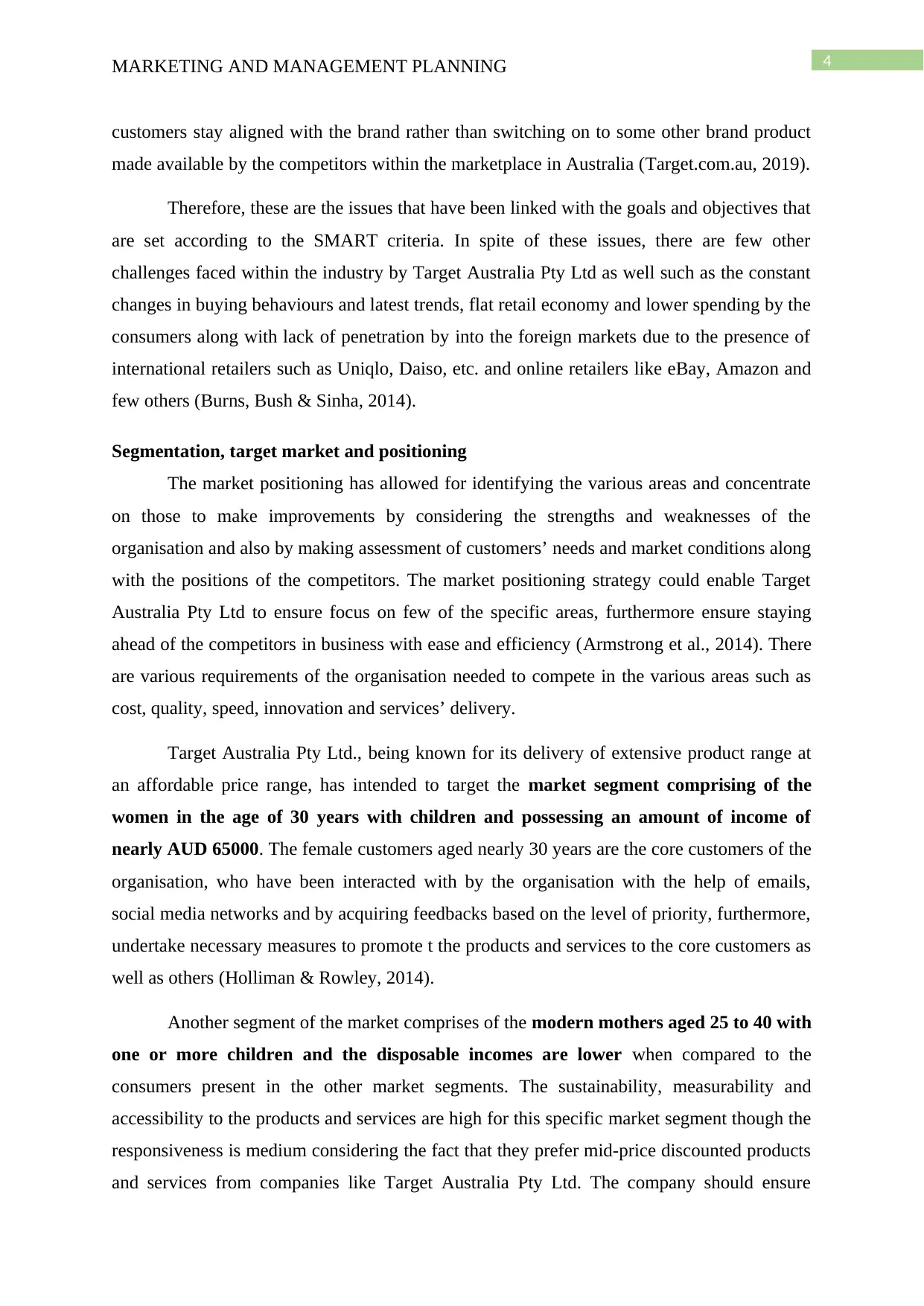
4MARKETING AND MANAGEMENT PLANNING
customers stay aligned with the brand rather than switching on to some other brand product
made available by the competitors within the marketplace in Australia (Target.com.au, 2019).
Therefore, these are the issues that have been linked with the goals and objectives that
are set according to the SMART criteria. In spite of these issues, there are few other
challenges faced within the industry by Target Australia Pty Ltd as well such as the constant
changes in buying behaviours and latest trends, flat retail economy and lower spending by the
consumers along with lack of penetration by into the foreign markets due to the presence of
international retailers such as Uniqlo, Daiso, etc. and online retailers like eBay, Amazon and
few others (Burns, Bush & Sinha, 2014).
Segmentation, target market and positioning
The market positioning has allowed for identifying the various areas and concentrate
on those to make improvements by considering the strengths and weaknesses of the
organisation and also by making assessment of customers’ needs and market conditions along
with the positions of the competitors. The market positioning strategy could enable Target
Australia Pty Ltd to ensure focus on few of the specific areas, furthermore ensure staying
ahead of the competitors in business with ease and efficiency (Armstrong et al., 2014). There
are various requirements of the organisation needed to compete in the various areas such as
cost, quality, speed, innovation and services’ delivery.
Target Australia Pty Ltd., being known for its delivery of extensive product range at
an affordable price range, has intended to target the market segment comprising of the
women in the age of 30 years with children and possessing an amount of income of
nearly AUD 65000. The female customers aged nearly 30 years are the core customers of the
organisation, who have been interacted with by the organisation with the help of emails,
social media networks and by acquiring feedbacks based on the level of priority, furthermore,
undertake necessary measures to promote t the products and services to the core customers as
well as others (Holliman & Rowley, 2014).
Another segment of the market comprises of the modern mothers aged 25 to 40 with
one or more children and the disposable incomes are lower when compared to the
consumers present in the other market segments. The sustainability, measurability and
accessibility to the products and services are high for this specific market segment though the
responsiveness is medium considering the fact that they prefer mid-price discounted products
and services from companies like Target Australia Pty Ltd. The company should ensure
customers stay aligned with the brand rather than switching on to some other brand product
made available by the competitors within the marketplace in Australia (Target.com.au, 2019).
Therefore, these are the issues that have been linked with the goals and objectives that
are set according to the SMART criteria. In spite of these issues, there are few other
challenges faced within the industry by Target Australia Pty Ltd as well such as the constant
changes in buying behaviours and latest trends, flat retail economy and lower spending by the
consumers along with lack of penetration by into the foreign markets due to the presence of
international retailers such as Uniqlo, Daiso, etc. and online retailers like eBay, Amazon and
few others (Burns, Bush & Sinha, 2014).
Segmentation, target market and positioning
The market positioning has allowed for identifying the various areas and concentrate
on those to make improvements by considering the strengths and weaknesses of the
organisation and also by making assessment of customers’ needs and market conditions along
with the positions of the competitors. The market positioning strategy could enable Target
Australia Pty Ltd to ensure focus on few of the specific areas, furthermore ensure staying
ahead of the competitors in business with ease and efficiency (Armstrong et al., 2014). There
are various requirements of the organisation needed to compete in the various areas such as
cost, quality, speed, innovation and services’ delivery.
Target Australia Pty Ltd., being known for its delivery of extensive product range at
an affordable price range, has intended to target the market segment comprising of the
women in the age of 30 years with children and possessing an amount of income of
nearly AUD 65000. The female customers aged nearly 30 years are the core customers of the
organisation, who have been interacted with by the organisation with the help of emails,
social media networks and by acquiring feedbacks based on the level of priority, furthermore,
undertake necessary measures to promote t the products and services to the core customers as
well as others (Holliman & Rowley, 2014).
Another segment of the market comprises of the modern mothers aged 25 to 40 with
one or more children and the disposable incomes are lower when compared to the
consumers present in the other market segments. The sustainability, measurability and
accessibility to the products and services are high for this specific market segment though the
responsiveness is medium considering the fact that they prefer mid-price discounted products
and services from companies like Target Australia Pty Ltd. The company should ensure
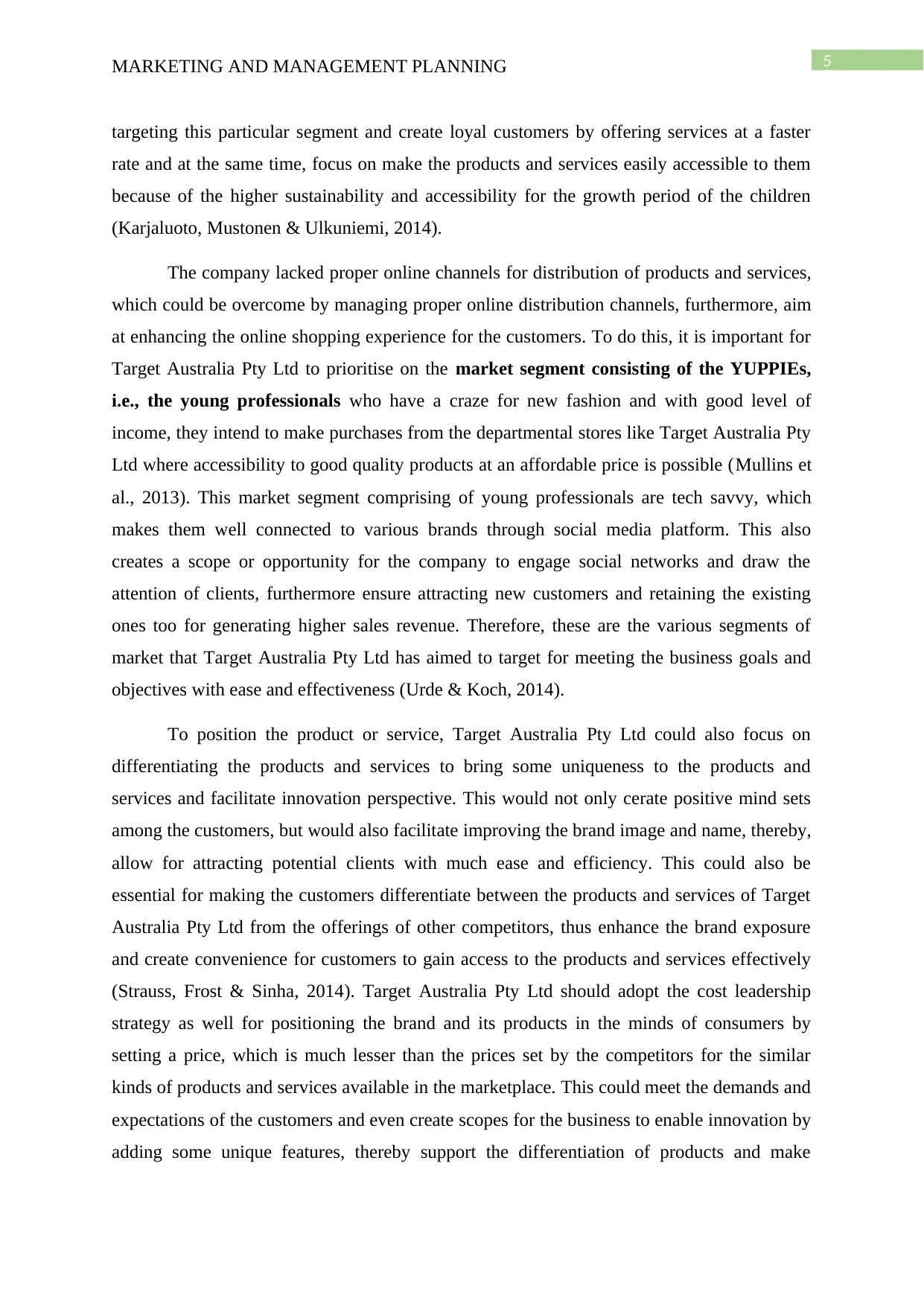
5MARKETING AND MANAGEMENT PLANNING
targeting this particular segment and create loyal customers by offering services at a faster
rate and at the same time, focus on make the products and services easily accessible to them
because of the higher sustainability and accessibility for the growth period of the children
(Karjaluoto, Mustonen & Ulkuniemi, 2014).
The company lacked proper online channels for distribution of products and services,
which could be overcome by managing proper online distribution channels, furthermore, aim
at enhancing the online shopping experience for the customers. To do this, it is important for
Target Australia Pty Ltd to prioritise on the market segment consisting of the YUPPIEs,
i.e., the young professionals who have a craze for new fashion and with good level of
income, they intend to make purchases from the departmental stores like Target Australia Pty
Ltd where accessibility to good quality products at an affordable price is possible (Mullins et
al., 2013). This market segment comprising of young professionals are tech savvy, which
makes them well connected to various brands through social media platform. This also
creates a scope or opportunity for the company to engage social networks and draw the
attention of clients, furthermore ensure attracting new customers and retaining the existing
ones too for generating higher sales revenue. Therefore, these are the various segments of
market that Target Australia Pty Ltd has aimed to target for meeting the business goals and
objectives with ease and effectiveness (Urde & Koch, 2014).
To position the product or service, Target Australia Pty Ltd could also focus on
differentiating the products and services to bring some uniqueness to the products and
services and facilitate innovation perspective. This would not only cerate positive mind sets
among the customers, but would also facilitate improving the brand image and name, thereby,
allow for attracting potential clients with much ease and efficiency. This could also be
essential for making the customers differentiate between the products and services of Target
Australia Pty Ltd from the offerings of other competitors, thus enhance the brand exposure
and create convenience for customers to gain access to the products and services effectively
(Strauss, Frost & Sinha, 2014). Target Australia Pty Ltd should adopt the cost leadership
strategy as well for positioning the brand and its products in the minds of consumers by
setting a price, which is much lesser than the prices set by the competitors for the similar
kinds of products and services available in the marketplace. This could meet the demands and
expectations of the customers and even create scopes for the business to enable innovation by
adding some unique features, thereby support the differentiation of products and make
targeting this particular segment and create loyal customers by offering services at a faster
rate and at the same time, focus on make the products and services easily accessible to them
because of the higher sustainability and accessibility for the growth period of the children
(Karjaluoto, Mustonen & Ulkuniemi, 2014).
The company lacked proper online channels for distribution of products and services,
which could be overcome by managing proper online distribution channels, furthermore, aim
at enhancing the online shopping experience for the customers. To do this, it is important for
Target Australia Pty Ltd to prioritise on the market segment consisting of the YUPPIEs,
i.e., the young professionals who have a craze for new fashion and with good level of
income, they intend to make purchases from the departmental stores like Target Australia Pty
Ltd where accessibility to good quality products at an affordable price is possible (Mullins et
al., 2013). This market segment comprising of young professionals are tech savvy, which
makes them well connected to various brands through social media platform. This also
creates a scope or opportunity for the company to engage social networks and draw the
attention of clients, furthermore ensure attracting new customers and retaining the existing
ones too for generating higher sales revenue. Therefore, these are the various segments of
market that Target Australia Pty Ltd has aimed to target for meeting the business goals and
objectives with ease and effectiveness (Urde & Koch, 2014).
To position the product or service, Target Australia Pty Ltd could also focus on
differentiating the products and services to bring some uniqueness to the products and
services and facilitate innovation perspective. This would not only cerate positive mind sets
among the customers, but would also facilitate improving the brand image and name, thereby,
allow for attracting potential clients with much ease and efficiency. This could also be
essential for making the customers differentiate between the products and services of Target
Australia Pty Ltd from the offerings of other competitors, thus enhance the brand exposure
and create convenience for customers to gain access to the products and services effectively
(Strauss, Frost & Sinha, 2014). Target Australia Pty Ltd should adopt the cost leadership
strategy as well for positioning the brand and its products in the minds of consumers by
setting a price, which is much lesser than the prices set by the competitors for the similar
kinds of products and services available in the marketplace. This could meet the demands and
expectations of the customers and even create scopes for the business to enable innovation by
adding some unique features, thereby support the differentiation of products and make
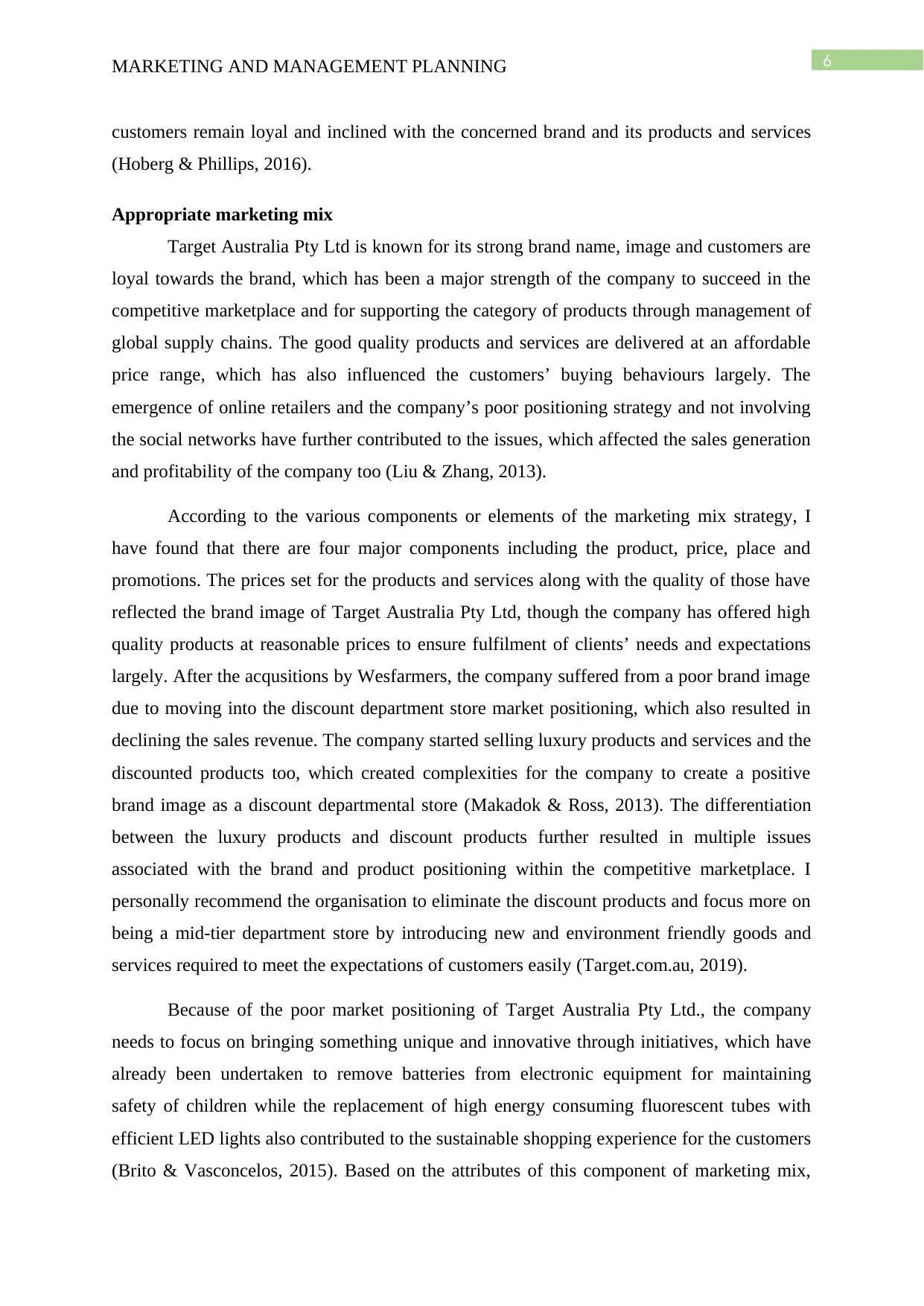
6MARKETING AND MANAGEMENT PLANNING
customers remain loyal and inclined with the concerned brand and its products and services
(Hoberg & Phillips, 2016).
Appropriate marketing mix
Target Australia Pty Ltd is known for its strong brand name, image and customers are
loyal towards the brand, which has been a major strength of the company to succeed in the
competitive marketplace and for supporting the category of products through management of
global supply chains. The good quality products and services are delivered at an affordable
price range, which has also influenced the customers’ buying behaviours largely. The
emergence of online retailers and the company’s poor positioning strategy and not involving
the social networks have further contributed to the issues, which affected the sales generation
and profitability of the company too (Liu & Zhang, 2013).
According to the various components or elements of the marketing mix strategy, I
have found that there are four major components including the product, price, place and
promotions. The prices set for the products and services along with the quality of those have
reflected the brand image of Target Australia Pty Ltd, though the company has offered high
quality products at reasonable prices to ensure fulfilment of clients’ needs and expectations
largely. After the acqusitions by Wesfarmers, the company suffered from a poor brand image
due to moving into the discount department store market positioning, which also resulted in
declining the sales revenue. The company started selling luxury products and services and the
discounted products too, which created complexities for the company to create a positive
brand image as a discount departmental store (Makadok & Ross, 2013). The differentiation
between the luxury products and discount products further resulted in multiple issues
associated with the brand and product positioning within the competitive marketplace. I
personally recommend the organisation to eliminate the discount products and focus more on
being a mid-tier department store by introducing new and environment friendly goods and
services required to meet the expectations of customers easily (Target.com.au, 2019).
Because of the poor market positioning of Target Australia Pty Ltd., the company
needs to focus on bringing something unique and innovative through initiatives, which have
already been undertaken to remove batteries from electronic equipment for maintaining
safety of children while the replacement of high energy consuming fluorescent tubes with
efficient LED lights also contributed to the sustainable shopping experience for the customers
(Brito & Vasconcelos, 2015). Based on the attributes of this component of marketing mix,
customers remain loyal and inclined with the concerned brand and its products and services
(Hoberg & Phillips, 2016).
Appropriate marketing mix
Target Australia Pty Ltd is known for its strong brand name, image and customers are
loyal towards the brand, which has been a major strength of the company to succeed in the
competitive marketplace and for supporting the category of products through management of
global supply chains. The good quality products and services are delivered at an affordable
price range, which has also influenced the customers’ buying behaviours largely. The
emergence of online retailers and the company’s poor positioning strategy and not involving
the social networks have further contributed to the issues, which affected the sales generation
and profitability of the company too (Liu & Zhang, 2013).
According to the various components or elements of the marketing mix strategy, I
have found that there are four major components including the product, price, place and
promotions. The prices set for the products and services along with the quality of those have
reflected the brand image of Target Australia Pty Ltd, though the company has offered high
quality products at reasonable prices to ensure fulfilment of clients’ needs and expectations
largely. After the acqusitions by Wesfarmers, the company suffered from a poor brand image
due to moving into the discount department store market positioning, which also resulted in
declining the sales revenue. The company started selling luxury products and services and the
discounted products too, which created complexities for the company to create a positive
brand image as a discount departmental store (Makadok & Ross, 2013). The differentiation
between the luxury products and discount products further resulted in multiple issues
associated with the brand and product positioning within the competitive marketplace. I
personally recommend the organisation to eliminate the discount products and focus more on
being a mid-tier department store by introducing new and environment friendly goods and
services required to meet the expectations of customers easily (Target.com.au, 2019).
Because of the poor market positioning of Target Australia Pty Ltd., the company
needs to focus on bringing something unique and innovative through initiatives, which have
already been undertaken to remove batteries from electronic equipment for maintaining
safety of children while the replacement of high energy consuming fluorescent tubes with
efficient LED lights also contributed to the sustainable shopping experience for the customers
(Brito & Vasconcelos, 2015). Based on the attributes of this component of marketing mix,
Paraphrase This Document
Need a fresh take? Get an instant paraphrase of this document with our AI Paraphraser
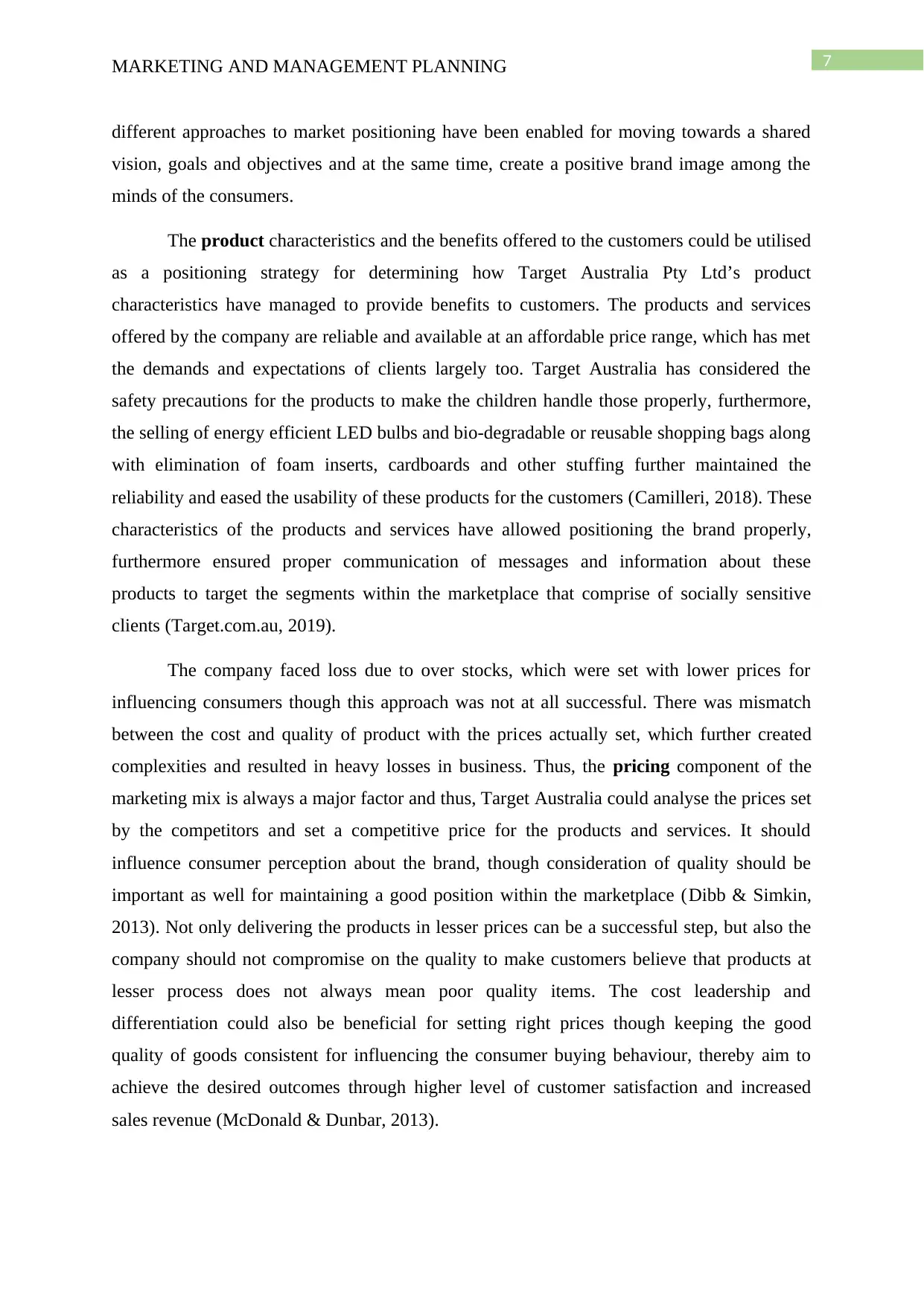
7MARKETING AND MANAGEMENT PLANNING
different approaches to market positioning have been enabled for moving towards a shared
vision, goals and objectives and at the same time, create a positive brand image among the
minds of the consumers.
The product characteristics and the benefits offered to the customers could be utilised
as a positioning strategy for determining how Target Australia Pty Ltd’s product
characteristics have managed to provide benefits to customers. The products and services
offered by the company are reliable and available at an affordable price range, which has met
the demands and expectations of clients largely too. Target Australia has considered the
safety precautions for the products to make the children handle those properly, furthermore,
the selling of energy efficient LED bulbs and bio-degradable or reusable shopping bags along
with elimination of foam inserts, cardboards and other stuffing further maintained the
reliability and eased the usability of these products for the customers (Camilleri, 2018). These
characteristics of the products and services have allowed positioning the brand properly,
furthermore ensured proper communication of messages and information about these
products to target the segments within the marketplace that comprise of socially sensitive
clients (Target.com.au, 2019).
The company faced loss due to over stocks, which were set with lower prices for
influencing consumers though this approach was not at all successful. There was mismatch
between the cost and quality of product with the prices actually set, which further created
complexities and resulted in heavy losses in business. Thus, the pricing component of the
marketing mix is always a major factor and thus, Target Australia could analyse the prices set
by the competitors and set a competitive price for the products and services. It should
influence consumer perception about the brand, though consideration of quality should be
important as well for maintaining a good position within the marketplace (Dibb & Simkin,
2013). Not only delivering the products in lesser prices can be a successful step, but also the
company should not compromise on the quality to make customers believe that products at
lesser process does not always mean poor quality items. The cost leadership and
differentiation could also be beneficial for setting right prices though keeping the good
quality of goods consistent for influencing the consumer buying behaviour, thereby aim to
achieve the desired outcomes through higher level of customer satisfaction and increased
sales revenue (McDonald & Dunbar, 2013).
different approaches to market positioning have been enabled for moving towards a shared
vision, goals and objectives and at the same time, create a positive brand image among the
minds of the consumers.
The product characteristics and the benefits offered to the customers could be utilised
as a positioning strategy for determining how Target Australia Pty Ltd’s product
characteristics have managed to provide benefits to customers. The products and services
offered by the company are reliable and available at an affordable price range, which has met
the demands and expectations of clients largely too. Target Australia has considered the
safety precautions for the products to make the children handle those properly, furthermore,
the selling of energy efficient LED bulbs and bio-degradable or reusable shopping bags along
with elimination of foam inserts, cardboards and other stuffing further maintained the
reliability and eased the usability of these products for the customers (Camilleri, 2018). These
characteristics of the products and services have allowed positioning the brand properly,
furthermore ensured proper communication of messages and information about these
products to target the segments within the marketplace that comprise of socially sensitive
clients (Target.com.au, 2019).
The company faced loss due to over stocks, which were set with lower prices for
influencing consumers though this approach was not at all successful. There was mismatch
between the cost and quality of product with the prices actually set, which further created
complexities and resulted in heavy losses in business. Thus, the pricing component of the
marketing mix is always a major factor and thus, Target Australia could analyse the prices set
by the competitors and set a competitive price for the products and services. It should
influence consumer perception about the brand, though consideration of quality should be
important as well for maintaining a good position within the marketplace (Dibb & Simkin,
2013). Not only delivering the products in lesser prices can be a successful step, but also the
company should not compromise on the quality to make customers believe that products at
lesser process does not always mean poor quality items. The cost leadership and
differentiation could also be beneficial for setting right prices though keeping the good
quality of goods consistent for influencing the consumer buying behaviour, thereby aim to
achieve the desired outcomes through higher level of customer satisfaction and increased
sales revenue (McDonald & Dunbar, 2013).
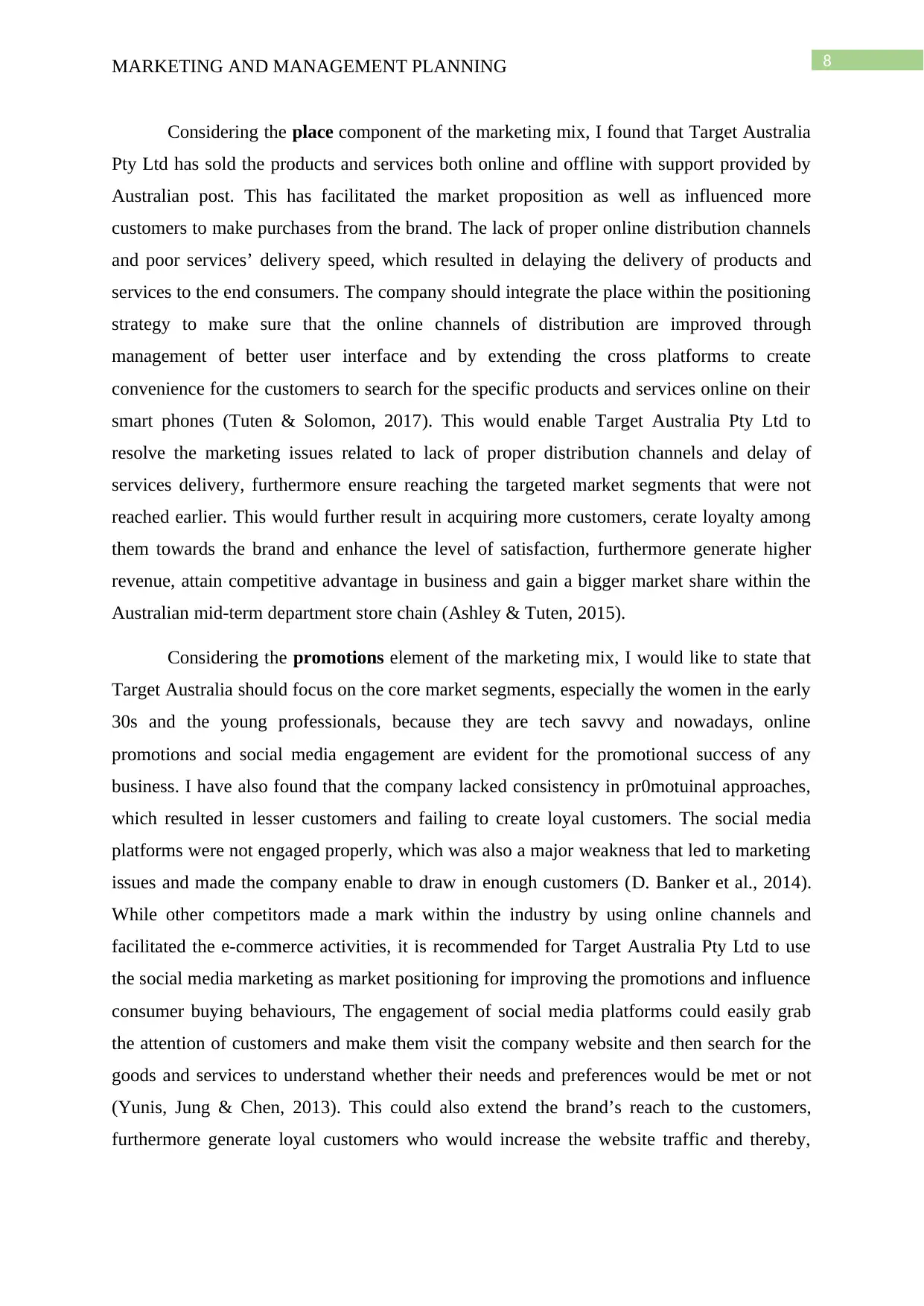
8MARKETING AND MANAGEMENT PLANNING
Considering the place component of the marketing mix, I found that Target Australia
Pty Ltd has sold the products and services both online and offline with support provided by
Australian post. This has facilitated the market proposition as well as influenced more
customers to make purchases from the brand. The lack of proper online distribution channels
and poor services’ delivery speed, which resulted in delaying the delivery of products and
services to the end consumers. The company should integrate the place within the positioning
strategy to make sure that the online channels of distribution are improved through
management of better user interface and by extending the cross platforms to create
convenience for the customers to search for the specific products and services online on their
smart phones (Tuten & Solomon, 2017). This would enable Target Australia Pty Ltd to
resolve the marketing issues related to lack of proper distribution channels and delay of
services delivery, furthermore ensure reaching the targeted market segments that were not
reached earlier. This would further result in acquiring more customers, cerate loyalty among
them towards the brand and enhance the level of satisfaction, furthermore generate higher
revenue, attain competitive advantage in business and gain a bigger market share within the
Australian mid-term department store chain (Ashley & Tuten, 2015).
Considering the promotions element of the marketing mix, I would like to state that
Target Australia should focus on the core market segments, especially the women in the early
30s and the young professionals, because they are tech savvy and nowadays, online
promotions and social media engagement are evident for the promotional success of any
business. I have also found that the company lacked consistency in pr0motuinal approaches,
which resulted in lesser customers and failing to create loyal customers. The social media
platforms were not engaged properly, which was also a major weakness that led to marketing
issues and made the company enable to draw in enough customers (D. Banker et al., 2014).
While other competitors made a mark within the industry by using online channels and
facilitated the e-commerce activities, it is recommended for Target Australia Pty Ltd to use
the social media marketing as market positioning for improving the promotions and influence
consumer buying behaviours, The engagement of social media platforms could easily grab
the attention of customers and make them visit the company website and then search for the
goods and services to understand whether their needs and preferences would be met or not
(Yunis, Jung & Chen, 2013). This could also extend the brand’s reach to the customers,
furthermore generate loyal customers who would increase the website traffic and thereby,
Considering the place component of the marketing mix, I found that Target Australia
Pty Ltd has sold the products and services both online and offline with support provided by
Australian post. This has facilitated the market proposition as well as influenced more
customers to make purchases from the brand. The lack of proper online distribution channels
and poor services’ delivery speed, which resulted in delaying the delivery of products and
services to the end consumers. The company should integrate the place within the positioning
strategy to make sure that the online channels of distribution are improved through
management of better user interface and by extending the cross platforms to create
convenience for the customers to search for the specific products and services online on their
smart phones (Tuten & Solomon, 2017). This would enable Target Australia Pty Ltd to
resolve the marketing issues related to lack of proper distribution channels and delay of
services delivery, furthermore ensure reaching the targeted market segments that were not
reached earlier. This would further result in acquiring more customers, cerate loyalty among
them towards the brand and enhance the level of satisfaction, furthermore generate higher
revenue, attain competitive advantage in business and gain a bigger market share within the
Australian mid-term department store chain (Ashley & Tuten, 2015).
Considering the promotions element of the marketing mix, I would like to state that
Target Australia should focus on the core market segments, especially the women in the early
30s and the young professionals, because they are tech savvy and nowadays, online
promotions and social media engagement are evident for the promotional success of any
business. I have also found that the company lacked consistency in pr0motuinal approaches,
which resulted in lesser customers and failing to create loyal customers. The social media
platforms were not engaged properly, which was also a major weakness that led to marketing
issues and made the company enable to draw in enough customers (D. Banker et al., 2014).
While other competitors made a mark within the industry by using online channels and
facilitated the e-commerce activities, it is recommended for Target Australia Pty Ltd to use
the social media marketing as market positioning for improving the promotions and influence
consumer buying behaviours, The engagement of social media platforms could easily grab
the attention of customers and make them visit the company website and then search for the
goods and services to understand whether their needs and preferences would be met or not
(Yunis, Jung & Chen, 2013). This could also extend the brand’s reach to the customers,
furthermore generate loyal customers who would increase the website traffic and thereby,
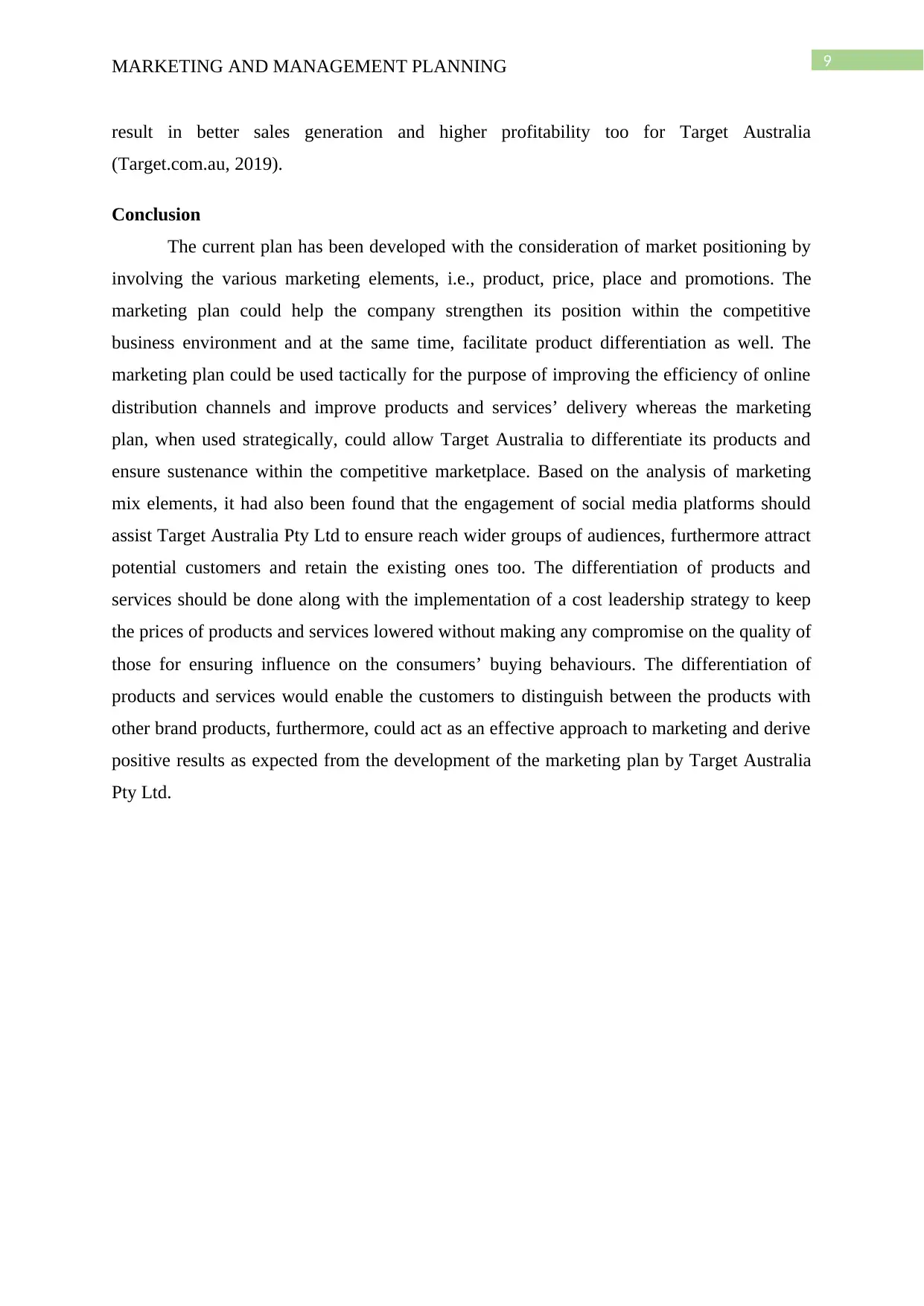
9MARKETING AND MANAGEMENT PLANNING
result in better sales generation and higher profitability too for Target Australia
(Target.com.au, 2019).
Conclusion
The current plan has been developed with the consideration of market positioning by
involving the various marketing elements, i.e., product, price, place and promotions. The
marketing plan could help the company strengthen its position within the competitive
business environment and at the same time, facilitate product differentiation as well. The
marketing plan could be used tactically for the purpose of improving the efficiency of online
distribution channels and improve products and services’ delivery whereas the marketing
plan, when used strategically, could allow Target Australia to differentiate its products and
ensure sustenance within the competitive marketplace. Based on the analysis of marketing
mix elements, it had also been found that the engagement of social media platforms should
assist Target Australia Pty Ltd to ensure reach wider groups of audiences, furthermore attract
potential customers and retain the existing ones too. The differentiation of products and
services should be done along with the implementation of a cost leadership strategy to keep
the prices of products and services lowered without making any compromise on the quality of
those for ensuring influence on the consumers’ buying behaviours. The differentiation of
products and services would enable the customers to distinguish between the products with
other brand products, furthermore, could act as an effective approach to marketing and derive
positive results as expected from the development of the marketing plan by Target Australia
Pty Ltd.
result in better sales generation and higher profitability too for Target Australia
(Target.com.au, 2019).
Conclusion
The current plan has been developed with the consideration of market positioning by
involving the various marketing elements, i.e., product, price, place and promotions. The
marketing plan could help the company strengthen its position within the competitive
business environment and at the same time, facilitate product differentiation as well. The
marketing plan could be used tactically for the purpose of improving the efficiency of online
distribution channels and improve products and services’ delivery whereas the marketing
plan, when used strategically, could allow Target Australia to differentiate its products and
ensure sustenance within the competitive marketplace. Based on the analysis of marketing
mix elements, it had also been found that the engagement of social media platforms should
assist Target Australia Pty Ltd to ensure reach wider groups of audiences, furthermore attract
potential customers and retain the existing ones too. The differentiation of products and
services should be done along with the implementation of a cost leadership strategy to keep
the prices of products and services lowered without making any compromise on the quality of
those for ensuring influence on the consumers’ buying behaviours. The differentiation of
products and services would enable the customers to distinguish between the products with
other brand products, furthermore, could act as an effective approach to marketing and derive
positive results as expected from the development of the marketing plan by Target Australia
Pty Ltd.
Secure Best Marks with AI Grader
Need help grading? Try our AI Grader for instant feedback on your assignments.
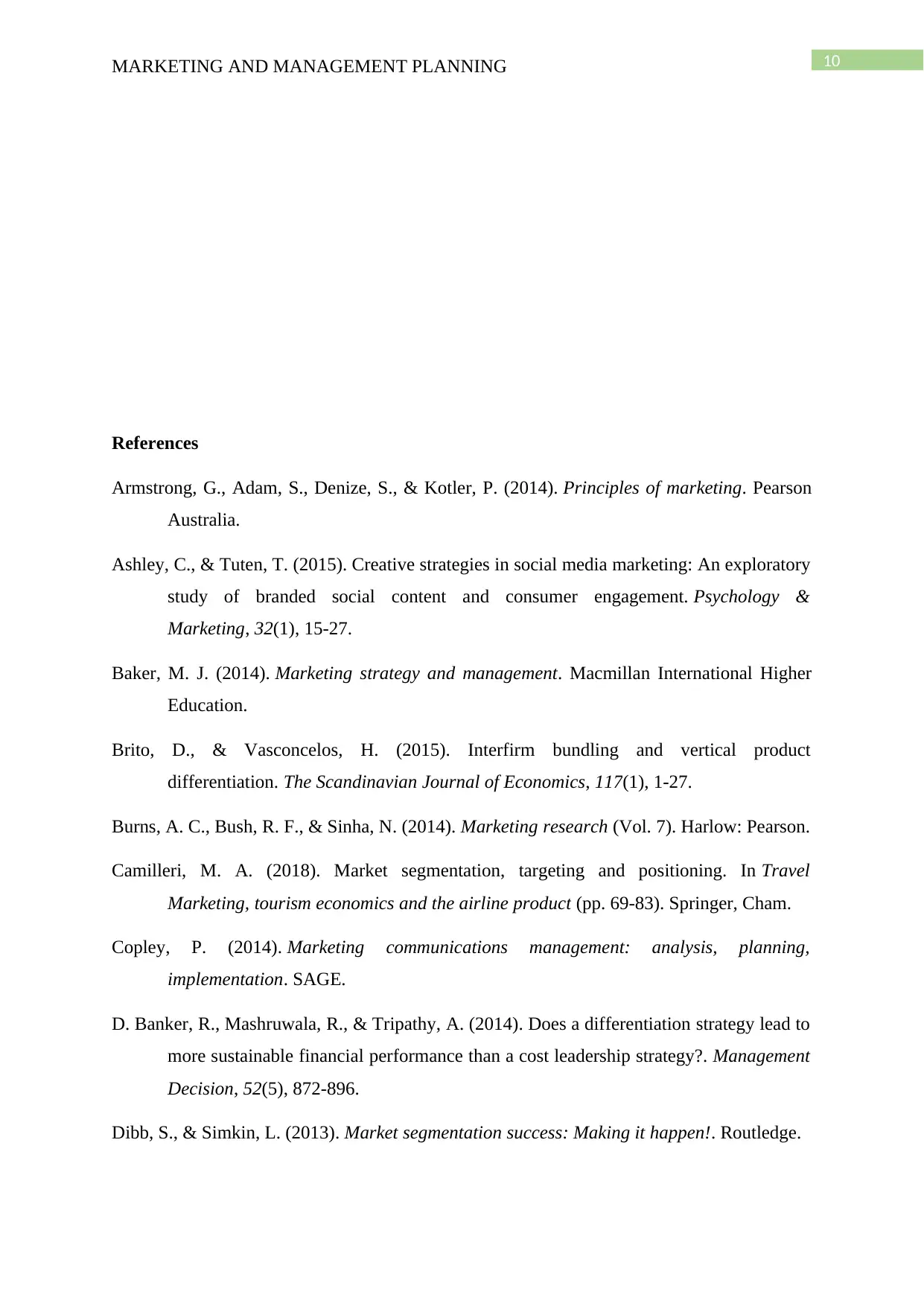
10MARKETING AND MANAGEMENT PLANNING
References
Armstrong, G., Adam, S., Denize, S., & Kotler, P. (2014). Principles of marketing. Pearson
Australia.
Ashley, C., & Tuten, T. (2015). Creative strategies in social media marketing: An exploratory
study of branded social content and consumer engagement. Psychology &
Marketing, 32(1), 15-27.
Baker, M. J. (2014). Marketing strategy and management. Macmillan International Higher
Education.
Brito, D., & Vasconcelos, H. (2015). Interfirm bundling and vertical product
differentiation. The Scandinavian Journal of Economics, 117(1), 1-27.
Burns, A. C., Bush, R. F., & Sinha, N. (2014). Marketing research (Vol. 7). Harlow: Pearson.
Camilleri, M. A. (2018). Market segmentation, targeting and positioning. In Travel
Marketing, tourism economics and the airline product (pp. 69-83). Springer, Cham.
Copley, P. (2014). Marketing communications management: analysis, planning,
implementation. SAGE.
D. Banker, R., Mashruwala, R., & Tripathy, A. (2014). Does a differentiation strategy lead to
more sustainable financial performance than a cost leadership strategy?. Management
Decision, 52(5), 872-896.
Dibb, S., & Simkin, L. (2013). Market segmentation success: Making it happen!. Routledge.
References
Armstrong, G., Adam, S., Denize, S., & Kotler, P. (2014). Principles of marketing. Pearson
Australia.
Ashley, C., & Tuten, T. (2015). Creative strategies in social media marketing: An exploratory
study of branded social content and consumer engagement. Psychology &
Marketing, 32(1), 15-27.
Baker, M. J. (2014). Marketing strategy and management. Macmillan International Higher
Education.
Brito, D., & Vasconcelos, H. (2015). Interfirm bundling and vertical product
differentiation. The Scandinavian Journal of Economics, 117(1), 1-27.
Burns, A. C., Bush, R. F., & Sinha, N. (2014). Marketing research (Vol. 7). Harlow: Pearson.
Camilleri, M. A. (2018). Market segmentation, targeting and positioning. In Travel
Marketing, tourism economics and the airline product (pp. 69-83). Springer, Cham.
Copley, P. (2014). Marketing communications management: analysis, planning,
implementation. SAGE.
D. Banker, R., Mashruwala, R., & Tripathy, A. (2014). Does a differentiation strategy lead to
more sustainable financial performance than a cost leadership strategy?. Management
Decision, 52(5), 872-896.
Dibb, S., & Simkin, L. (2013). Market segmentation success: Making it happen!. Routledge.
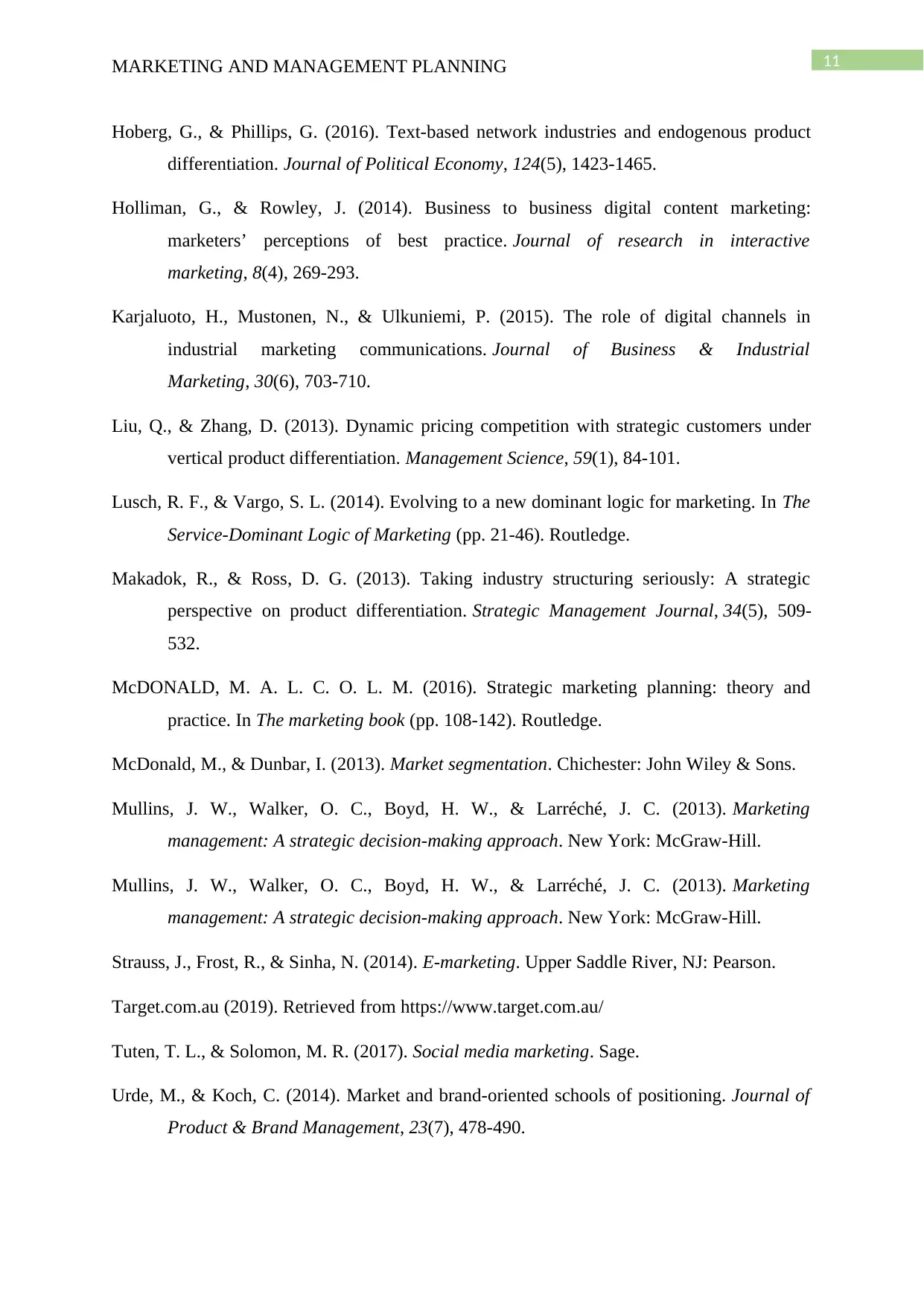
11MARKETING AND MANAGEMENT PLANNING
Hoberg, G., & Phillips, G. (2016). Text-based network industries and endogenous product
differentiation. Journal of Political Economy, 124(5), 1423-1465.
Holliman, G., & Rowley, J. (2014). Business to business digital content marketing:
marketers’ perceptions of best practice. Journal of research in interactive
marketing, 8(4), 269-293.
Karjaluoto, H., Mustonen, N., & Ulkuniemi, P. (2015). The role of digital channels in
industrial marketing communications. Journal of Business & Industrial
Marketing, 30(6), 703-710.
Liu, Q., & Zhang, D. (2013). Dynamic pricing competition with strategic customers under
vertical product differentiation. Management Science, 59(1), 84-101.
Lusch, R. F., & Vargo, S. L. (2014). Evolving to a new dominant logic for marketing. In The
Service-Dominant Logic of Marketing (pp. 21-46). Routledge.
Makadok, R., & Ross, D. G. (2013). Taking industry structuring seriously: A strategic
perspective on product differentiation. Strategic Management Journal, 34(5), 509-
532.
McDONALD, M. A. L. C. O. L. M. (2016). Strategic marketing planning: theory and
practice. In The marketing book (pp. 108-142). Routledge.
McDonald, M., & Dunbar, I. (2013). Market segmentation. Chichester: John Wiley & Sons.
Mullins, J. W., Walker, O. C., Boyd, H. W., & Larréché, J. C. (2013). Marketing
management: A strategic decision-making approach. New York: McGraw-Hill.
Mullins, J. W., Walker, O. C., Boyd, H. W., & Larréché, J. C. (2013). Marketing
management: A strategic decision-making approach. New York: McGraw-Hill.
Strauss, J., Frost, R., & Sinha, N. (2014). E-marketing. Upper Saddle River, NJ: Pearson.
Target.com.au (2019). Retrieved from https://www.target.com.au/
Tuten, T. L., & Solomon, M. R. (2017). Social media marketing. Sage.
Urde, M., & Koch, C. (2014). Market and brand-oriented schools of positioning. Journal of
Product & Brand Management, 23(7), 478-490.
Hoberg, G., & Phillips, G. (2016). Text-based network industries and endogenous product
differentiation. Journal of Political Economy, 124(5), 1423-1465.
Holliman, G., & Rowley, J. (2014). Business to business digital content marketing:
marketers’ perceptions of best practice. Journal of research in interactive
marketing, 8(4), 269-293.
Karjaluoto, H., Mustonen, N., & Ulkuniemi, P. (2015). The role of digital channels in
industrial marketing communications. Journal of Business & Industrial
Marketing, 30(6), 703-710.
Liu, Q., & Zhang, D. (2013). Dynamic pricing competition with strategic customers under
vertical product differentiation. Management Science, 59(1), 84-101.
Lusch, R. F., & Vargo, S. L. (2014). Evolving to a new dominant logic for marketing. In The
Service-Dominant Logic of Marketing (pp. 21-46). Routledge.
Makadok, R., & Ross, D. G. (2013). Taking industry structuring seriously: A strategic
perspective on product differentiation. Strategic Management Journal, 34(5), 509-
532.
McDONALD, M. A. L. C. O. L. M. (2016). Strategic marketing planning: theory and
practice. In The marketing book (pp. 108-142). Routledge.
McDonald, M., & Dunbar, I. (2013). Market segmentation. Chichester: John Wiley & Sons.
Mullins, J. W., Walker, O. C., Boyd, H. W., & Larréché, J. C. (2013). Marketing
management: A strategic decision-making approach. New York: McGraw-Hill.
Mullins, J. W., Walker, O. C., Boyd, H. W., & Larréché, J. C. (2013). Marketing
management: A strategic decision-making approach. New York: McGraw-Hill.
Strauss, J., Frost, R., & Sinha, N. (2014). E-marketing. Upper Saddle River, NJ: Pearson.
Target.com.au (2019). Retrieved from https://www.target.com.au/
Tuten, T. L., & Solomon, M. R. (2017). Social media marketing. Sage.
Urde, M., & Koch, C. (2014). Market and brand-oriented schools of positioning. Journal of
Product & Brand Management, 23(7), 478-490.
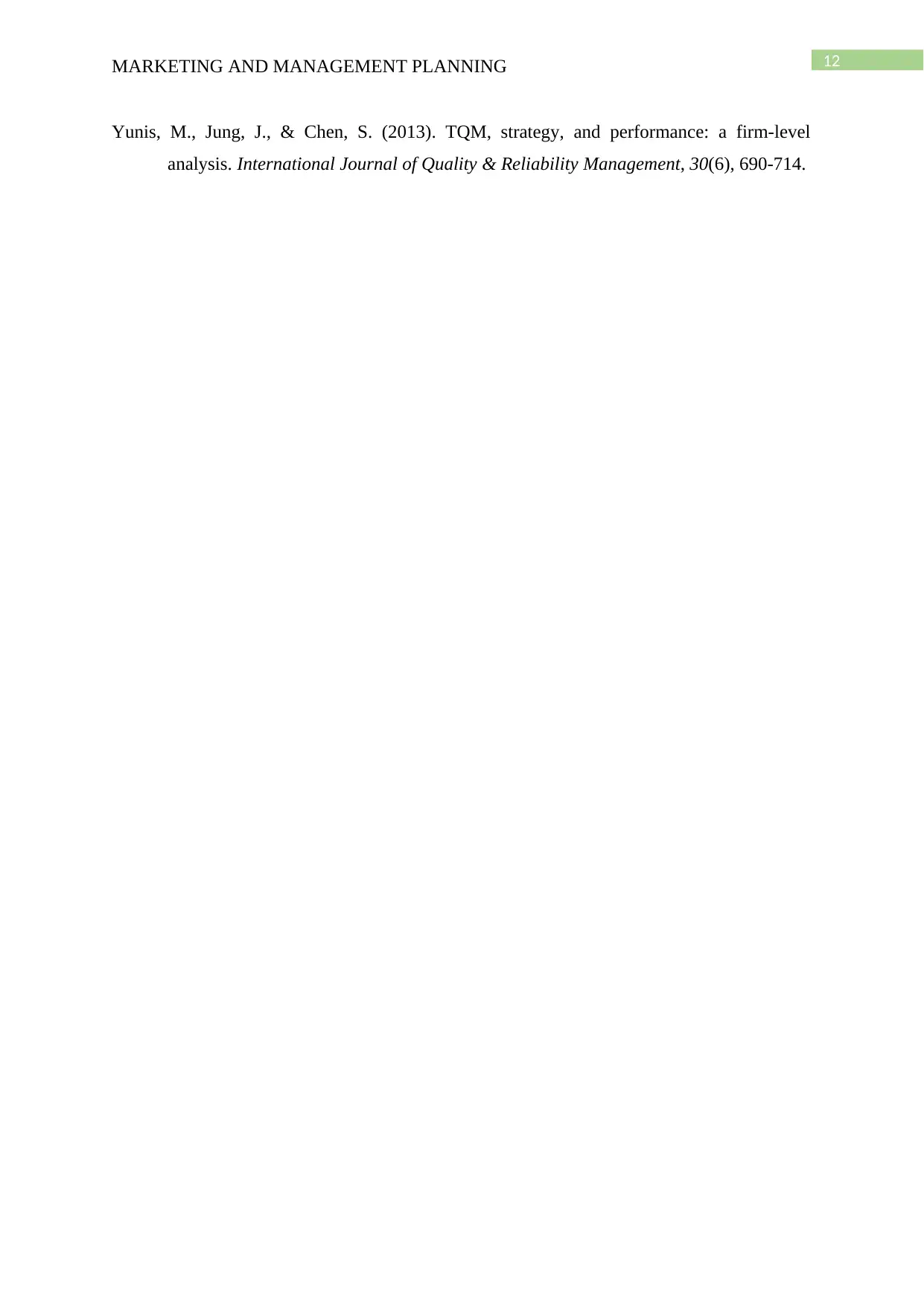
12MARKETING AND MANAGEMENT PLANNING
Yunis, M., Jung, J., & Chen, S. (2013). TQM, strategy, and performance: a firm-level
analysis. International Journal of Quality & Reliability Management, 30(6), 690-714.
Yunis, M., Jung, J., & Chen, S. (2013). TQM, strategy, and performance: a firm-level
analysis. International Journal of Quality & Reliability Management, 30(6), 690-714.
1 out of 13
Related Documents
Your All-in-One AI-Powered Toolkit for Academic Success.
+13062052269
info@desklib.com
Available 24*7 on WhatsApp / Email
![[object Object]](/_next/static/media/star-bottom.7253800d.svg)
Unlock your academic potential
© 2024 | Zucol Services PVT LTD | All rights reserved.





